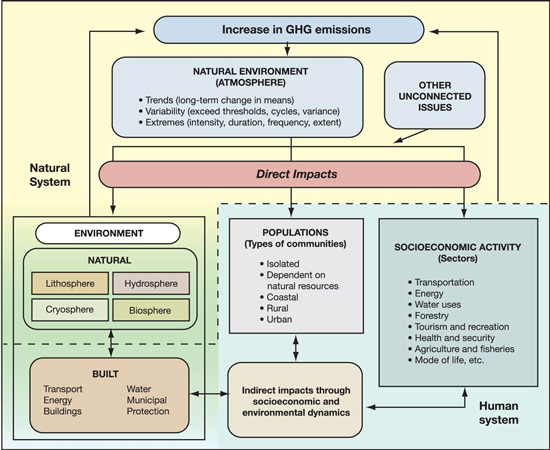Introduction - Quebec
The objective of this chapter is to update existing assessments (Bergeron et al., 1997; Ouranos, 2004; Lemmen and Warren, 2004) on sensitivity, impacts and adaptation to climate change; this summary of information concerning Quebec should thus contribute to a better understanding of the phenomenon and lead to the discovery of solution pathways.
Figure 1 presents the problem of impacts and shows how atmospheric conditions can directly or indirectly affect natural and human systems, either subtly or suddenly. All climate change impacts can be grouped into three elements that will react and adapt to the new situations (see United States Global Change Research Program, 2000). These three 'key elements' are population (human beings), the natural and built environment (their surroundings) and socioeconomic activity (the human dynamic), all of which can sustain direct impacts from changes in mean temperatures, variability and climate extremes, so long as they are exposed and sensitive to them. Moreover, any impact on one element can have repercussions on the other two as a result of indirect impacts; these are generally more difficult to quantify and are responsible for the complexity of overall impacts. For example, consider the effect of extreme precipitation events becoming more abundant: they directly influence the hydrosphere and frequency of sewer overflows and have an indirect influence on the frequency of residential flooding, as well as on public health, utility interruptions and the state of the economy, and thus lead to many other cascading effects. Given the scope of the problem, the Quebec chapter restricts itself to presenting a summary of the most important anticipated issues, based on available documentation.
Figure 1 raises one of the great challenges of this kind of synthesis, which is to choose an approach that makes the classifying and grouping of the many issues possible while dealing with cumulative and cross issues.

FIGURE 1: Direct and indirect impacts of climate, its variability and its extremes on the three key elements (the environment [natural or built], the population and socioeconomic activity), illustrating the significant influence and complexity of climate impacts. Other issues, such as technological development, societal choices, infrastructure aging and demographic changes, occur in parallel and interact with these climate changes. It should be noted that, in this document, the natural environment refers to the five climate subsystems defined by Peixoto and Oort (1992), in which the atmosphere is the initiator of the climate change that causes these impacts.
[ larger image ]
Text version
Figure 1
Flow chart demonstrating the impacts of the natural environment (atmosphere) which includes climate trends (long-term change in means), variability (exceeding thresholds, cycles, variance) and extremes (intensity, duration, frequency, extent) on the natural and human systems. The environment, populations and socioeconomic activity are directly affected by the atmosphere and other connected issues. Our environment can be natural (lithosphere, hydrosphere, cryosphere and biosphere) and built, which is a part of the human system and includes transport, energy, buildings, water, municipal and protection infrastructure. Populations, or types of communities, can be isolated, dependent on natural resources, coastal, rural or urban. Socioeconomic activities, or sectors, include transportation, energy, water uses, forestry, tourism and recreation, health and security, agriculture and fisheries, and mode of life among others. Environment, populations and socioeconomic activity interact as a result of indirect impacts through socioeconomic and environmental dynamics as a part of the human system. The natural and human systems increase Greenhouse Gas Emissions.
Following the 'Introduction', in which general information and concepts are presented, Section 2 briefly describes the current characteristics and evolution of the three 'key elements' under the influence of climate change. Section 3 constitutes the core of this update and outlines the current state of knowledge regarding the four subregions of Quebec and the three key elements. Finally, Section 4 presents a synthesis and recommendations to guide the development of the science of climate change, which includes research on climate, improvement of knowledge on expected impacts and the evolution of everything related to adaptation, an emerging theme of recent years. This science of climate change will become increasingly necessary for effective decision-making.
Page details
- Date modified: